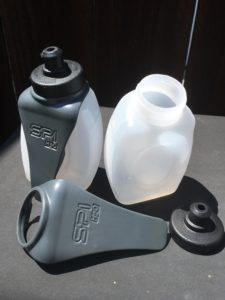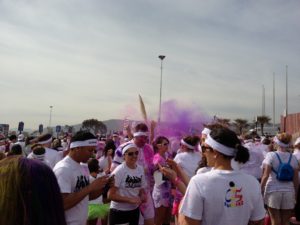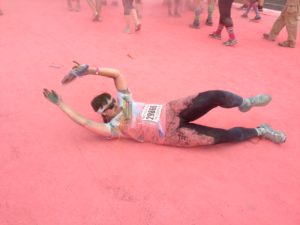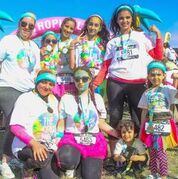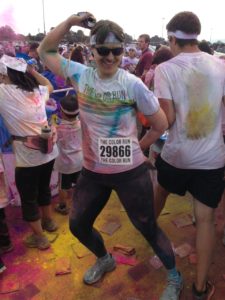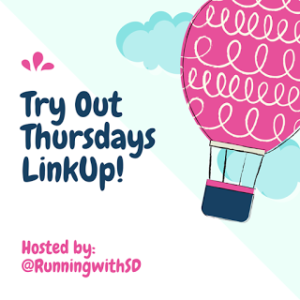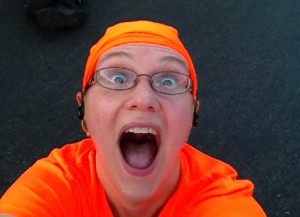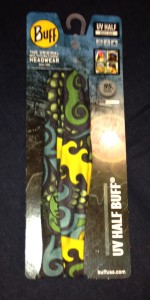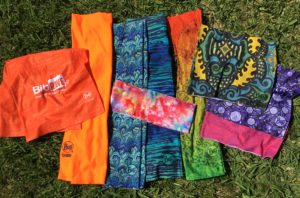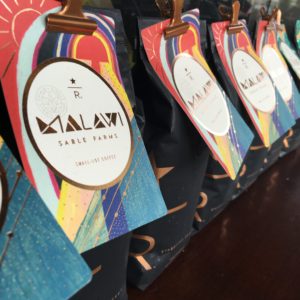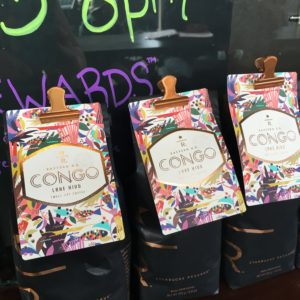[Elevation chart above taken from the Revel Mt. Charleston website. All rights belong to them. If asked to remove it, I will.]
When my friend Jackie asked me if i wanted to run a race in Las Vegas, my first reaction was “Sure! When?” I’ve only run two other races in the Las Vegas area, the Rock ‘n’ Roll Las Vegas Half Marathon (multiple times) and the Sin City Shootout, and enjoyed both, so why not? That’s how i decided to run Revel Mt. Charleston–I signed up a few days later.
While I had never run a Revel race, many of my friends had run the Revel Canyon City race and enjoyed it. Since they all said it was a class act, I figured it wasn’t too much of a risk–plus it would be an excellent excuse to hang out with Jackie, and all I had to do was show up.
Luckily I was going to be working in Southern California, just one short plane hop to Las Vegas. Not-so-luckily there was a giant storm and they shut down McCarran, so my 55 minute flight took more than six hours to get off the ground, and I had to miss the expo.
Jackie reported the expo was fairly small–remember we both do tons of races and have seen expos that look like mini-malls–but well organized. Once I figured out I was likely to miss the expo (even though it was open until 8 pm!), I sent Jackie a text with my driver’s license and asked her to get my packet. Revel allowed her to pick up my packet, which I really appreciated.
Speaking of the packet, I was impressed. The drawstring bag came pre-tagged with my bib tag, so I didn’t have to do anything to it before using it as a sweat-check bag. Not only that, if you had registered early enough to personalized you bib (Jackie did, I did not) the race bib’s reverse was pre-printed with the emergency contact information from online registration. Nifty!
In addition to just a few race postcards (for the Revel series, and a few others that might be of interest to Revel-ers) and a few samples, the packet included a cold weather kit: runner gloves, a heat sheet (folded in a tiny pouch), and a sweet tech-fabric beanie that even had a hole for my ponytail. Race shirts came in three varieties, and at registration the runners could choose a tank, a short sleeved shirt, or a long sleeved shirt. I love the ombre design and colors, as well as the turtle-shell logo for Mt. Charleston.
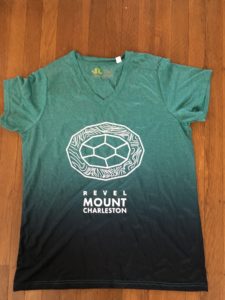
Just like at Disney, race day started way the flapjack too early. Since the course was a point-to-point, there was bus service up to the starting point, and we’d run back. Parking was in a shopping center and quite plentiful. The bus service used charter coaches (not school buses) and seemed to run very smoothly. A belated thank you to the volunteer who told me I was about to get on the marathon bus, or this story would not have had a happy ending!
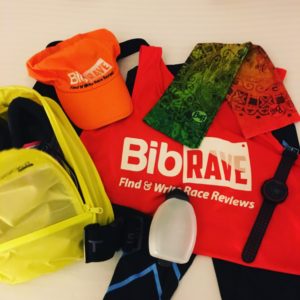
The marathon and half marathon were both on Mt. Charleston, with the entire course running down the mountain (until the last few miles). Marathoners started nearer to the top of the mountain, with half marathoners starting at marathon mile 13. The marathon runners reported starting temperatures in the 30s, and snow on the ground! From the half marathon start we could see the snow, but the temperatures were quite a bit warmer–mid-40s at the start.
The half marathon staging area had a gigantic bank of porta-potties, a hydration station with both water and gatorade, trucks for the sweat-check bags, and plenty of room to mill about and selfie. The desert mountain scenery was pretty, so there was hot and frantic selfie-taking action! (I suppose if you live in that scenery, you were probably looking at the rest of us and wondering what the big deal was.) I snapped a #Buffie with Smitha, marveled at how short the porta-potty lines were (race directors, take note: more potties = shorter lines), and yapped with Jackie about what the race plan would be. Smitha pointed out that the race director was boots-on-the-ground, wearing a safety vest and directing bus traffic. That’s pretty awesome, and the kind of all-hands teamwork I love to see in the running community.
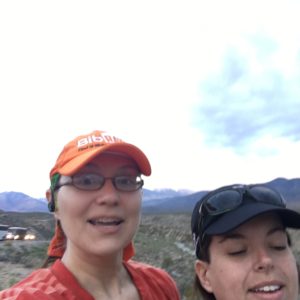
The race start was a short walk down the mountain road. While there was a clearly marked start, there was no clearly defined START to the race. As we were walking down, I heard many people saying what I was thinking: “wait, did the race already start?” On the one hand, I’ve never been to a race where people just got to the starting line and started, so it was pretty weird. On the other hand, it did work wonders to keep the race traffic appropriately spaced out on the course. Overall I liked it, but I would have liked some warning (“start will be at 6:30 or whenever you hit the starting line”) so I could set my expectations accordingly. (Of course if I had remembered Carlee’s review of the Revel in California, I would have expected this.)
The course was 100% on paved roads in good repair. Most of the half marathon course headed down the mountain, with the last 3 miles or so veering off to the right to return to the start. Runners had about half of one of the lanes on this four-lane road, plus a generous shoulder; the remainder of the road was open to police-directed/escorted traffic. One nice perk of this course is that the road was NOT canted for rain-drainage purposes. (You know how sometimes you’re running on the outer lane and it’s very clear your left foot doesn’t have as far to go down as your right? Then maybe your SI joint starts to whine? None of that here.) My guess is that this is because the road itself is downhill with very slight curvature, allowing the water to naturally drain away. Overall, a great surface to run on–no potholes, dips, chips, or other road hazards.
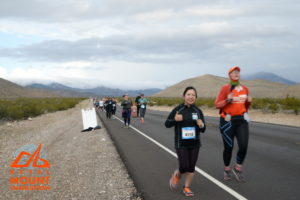
For the first mile, I felt like I was FLYING. The course was clearly downhill, even though driving up to the start didn’t feel like much of a climb. It wasn’t such a huge grade that I was worried about momentum (you know, like when you feel like you’re gaining so much speed that you might fall over and you start to rein in that momentum). Since I hadn’t done any downhill-specific training–and yes, the Revel website does quite clearly recommend hill training!–I was working on managing my energy output. Before the race I had turned off the interval function on my Garmin, and initially ran and walked random, untimed, intervals. (Later on I switched to using the metal posts by the side of the road, doing a run-2, walk-1, for example.) This mainly worked out well.
Similar to my experience in Sedona, I had to really work on my breathing. As a flat-lander, my lungs don’t want anything to do with elevation. It took about 4 miles for me to get into a good breathing rhythm, and even so the prime movers felt a little fire. At times I’d run until it hurt to breathe, then walk until I’d recovered. There were plenty of people also running intervals–timed, distance, or random–and much to my great delight, everyone signaled their stops and slow traffic kept right. (It’s not rocket science–the rules of the road are very simple–but some runners are so rude!)
At mile 3 I noticed my run intervals were around 9:35/mile pace (though I wasn’t running an entire mile at a time). That’s pretty darned FINE for me. I continued to run my intervals at that pace (or sometimes faster!) for quite a few more miles. Through miles 4, 5, and 6 I still felt like I was just cruising down that hill–no surprise, since I’d looked at the course elevations, and the first six miles had the most slope. By mile 6 I was pretty sure I had killed my 10k PR (though I haven’t looked at the data to confirm).
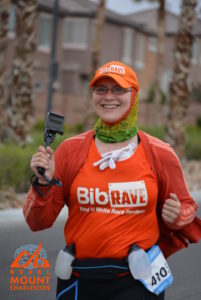
Around mile 8, I started to feel a hot spot on my left foot, along the arch. This was puzzling, as I had worn my usual foot gear (wonky toe taped, 2Toms Sport Shield applied, Wright’s Double Layer socks) and the Brooks Glycerin didn’t have that many miles on them (I’m guessing under 150, based on my total mileage this year and the races/runs for which I have worn other shoes). At first I thought I had something inside my shoe, and I stopped to fish it out, but that wasn’t it. At mile 10 I considered my sock might have wadded up, and I stopped to straighten it out, but that wasn’t it either. (I’m going to be working with the good folks at Brooks to figure this out–I’ve never had a problem with any pair of Brooks, so this is an anomaly.)
As the course came to the bottom of the run down the mountain, it turned right to run along some roads and head to the finish (a park by where we had parked). The course flattened out quite a bit, and there were a few uphill sections (what the what?), one up to the freeway’s service drive, and another up to the overpass. We ran a brief section by the freeway, but mostly through residential areas. There was a volunteer/course marshall at every turn, so getting lost was not an option.
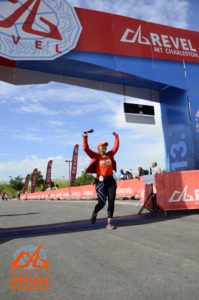
As we turned the second-to-last turn we started to run past spectators! Since there were basically none (other than aid station volunteers) on the mountain, this gave me another kick of energy. There were lots of kids holding signs to cheer on mom and/or dad. When I hit the final turn and saw the finish line, I took everything I had to sprint, blister-in-formation be darned, across that finish line. Then I hit stop on my Garmin. (Or so I thought…) PR achieved! In fact, I actually beat my old PR by a few minutes (not that I’m fast), which impressed me because my prior PR I was about 20 pounds lighter and in much better shape. (So if I start training now…)
The finisher chute had bananas and water and carbs. Better, there was hot pizza! Better, there was pie!! I had a slice of ‘za and a slice of pumpkin, met up with Jackie, and wandered out into the now-sunny park to hang out for a bit.
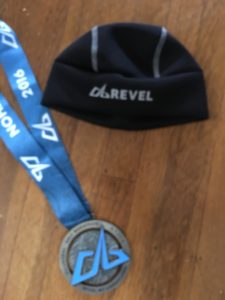
The park had a few booths from miscellaneous vendors, a massage tent, a tent with Revel merchandise, and a stage with live music. I put my feet up on one of the chairs and relaxed in the grass for a bit. There were also several backdrops with signs and such for taking photos. Oh right, almost forgot another cool benefit: Revel gives runners FREE race photos. (Yup, that’s free, no additional charge, go ahead and download them all.)
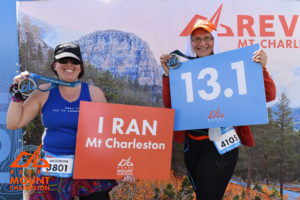
After we walked back to the car, drove over to brunch, ordered, and sat down…I noticed I hadn’t even paused my Garmin. Whomp, whomp, sad trombone noise for me! User error aside, I had a fantastic race and would gladly do this one again. Have you run Revel? Join me at the next one?
